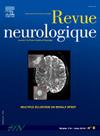与视觉分析相比,白质异常自动分割能更好地解释中风后的认知结果。
IF 2.8
4区 医学
Q2 CLINICAL NEUROLOGY
引用次数: 0
摘要
背景和目的:之前报道的脑卒中后患者白质异常(WMA)与认知能力下降之间的关系主要是通过视觉量表来记录的。然而,WMA 的自动分割可精确测定 WMA 的体积。然而,这种方法很少用于脑卒中人群,而且其与视觉量表相比的潜在优势仍未确定。本研究的目的是探讨自动分割 WMA 是否比视觉法泽卡斯量表和瓦伦德量表更能说明中风患者执行功能和处理速度的下降情况:分析对象是亚眠中心脑卒中后六个月进行磁共振成像的 358 名 GRECogVASC 队列患者。使用 Fazekas(皮层下异常)和 Wahlund 量表对 WMA 进行视觉分析。使用 LST(3.0.3)进行分割。在初步研究确定最佳分割阈值后,我们使用接收器操作特征曲线(ROC)检查了认知状态与每个阈值下计算的 WMA 体积之间的关系。最后,我们使用双变量皮尔逊相关分析评估了 Fazekas 和 Wahlund 视觉评分和 WMA 体积对认知评分的解释能力,比较了 Fisher 转换后的相关系数,并在调整病变体积后重复了相关分析:提高阈值会导致 WMA 被低估(P=0.0001)(阈值≥0.2 时显著),并改善对卒中腔信号变化(P=0.02)(阈值≤0.5 时显著)、易感伪影(P=0.002)(阈值≤0.6 时显著)和皮质脊髓变性(P=0.03)(阈值≤0.5 时显著)的正确剔除。随着阈值的升高,WMA 体积减小(P=0.0001)。曲线下面积(AUC)并不因阈值而异(处理速度:P=0.85;执行认知功能:P=0.7)。认知评分与 WMA 之间的相关系数在 WMA 容量方面高于 Fazekas(处理速度:Z=-3.442,P=0.001;执行功能:Z=-2.751,P=0.006)和 Wahlund 评分(处理速度:Z=-3.615,P=0.0001;执行功能:Z=-2.769,P=0.0001):Z=-2.769,P=0.006)。对病变体积的调整并没有改变与 WMA 体积的相关性(处理速度:r=-0.327 [95%CI:-0.416;-0.223],P=0.0001;执行功能:r=-0.262 [95%CI:-0.363;-0.150],P=0.0001):本研究表明,与视觉分析相比,通过自动分割评估的 WMA 体积能更好地说明认知障碍。结论:本研究表明,与视觉分析相比,通过自动分割评估的 WMA 容量能更好地说明认知障碍,这将有利于其更广泛地用于完善卒中后认知障碍的影像学决定因素。本文章由计算机程序翻译,如有差异,请以英文原文为准。
Poststroke cognitive outcome is better accounted for by white matter abnormalities automated segmentation than visual analysis
Background and aims
The association between white matter abnormalities (WMA) and cognitive decline previously reported in poststroke patients has been mainly documented using visual scales. However, automated segmentation of WMA provides a precise determination of the volume of WMA. Nonetheless, it is rarely used in the stroke population and its potential advantage over visual scales is still unsettled. The objective of this study was to examine whether automated segmentation of WMA provides a better account than the visual Fazekas and Wahlund scales of the decline in executive functions and processing speed in stroke patients.
Methods
The analyses were conducted on the 358 patients of the GRECogVASC cohort with an MRI performed at six months poststroke in the Amiens center. WMA were visually analyzed using the Fazekas (subcortical abnormalities) and Wahlund scales. Segmentation was performed using LST (3.0.3). Following preliminary studies to determine the optimal segmentation threshold, we examined the relationship between cognitive status and WMA volume computed at each threshold using receiver operating characteristic (ROC) curves. Finally, we assessed the ability of both Fazekas and Wahlund visual scores and WMA volume to account for cognitive scores by using a bivariate Pearson correlation analysis, comparing correlation coefficients with the Fisher transformation and repeating correlation analysis after adjustment for the lesion volume.
Results
Increasing the threshold led to an underestimation of WMA (P = 0.0001) (significant for a threshold ≥ 0.2) and an improvement in correct rejection of signal changes in the stroke cavity (P = 0.02) (significant for a threshold ≤ 0.5), susceptibility artifacts (P = 0.002) (significant for a threshold ≤ 0.6), and corticospinal degeneration (P = 0.03) (significant for a threshold ≤ 0.5). WMA volume decreased with increasing threshold (P = 0.0001). Areas under the curve (AUC) did not differ according to the threshold (processing speed: P = 0.85, executive cognitive functions: P = 0.7). Correlation coefficients between cognitive scores and WMA were higher for WMA volume than the Fazekas (processing speed: Z = −3.442, P = 0.001; executive functions: Z = −2.751, P = 0.006) and Wahlund scores (processing speed: Z = −3.615, P = 0.0001; executive functions: Z = −2.769, P = 0.006). Adjustment for lesion volume did not alter the correlations with WMA volume (processing speed: r = −0.327 [95%CI: −0.416; −0.223], P = 0.0001; executive functions: r = −0.262 [95%CI: −0.363; −0.150], P = 0.0001).
Conclusion
This study shows that WMA volume assessed by automated segmentation provides a better account of cognitive disorders than visual analysis. This should favor its wider use to refine imaging determinants of poststroke cognitive disorders.
求助全文
通过发布文献求助,成功后即可免费获取论文全文。
去求助
来源期刊

Revue neurologique
医学-临床神经学
CiteScore
4.80
自引率
0.00%
发文量
598
审稿时长
55 days
期刊介绍:
The first issue of the Revue Neurologique, featuring an original article by Jean-Martin Charcot, was published on February 28th, 1893. Six years later, the French Society of Neurology (SFN) adopted this journal as its official publication in the year of its foundation, 1899.
The Revue Neurologique was published throughout the 20th century without interruption and is indexed in all international databases (including Current Contents, Pubmed, Scopus). Ten annual issues provide original peer-reviewed clinical and research articles, and review articles giving up-to-date insights in all areas of neurology. The Revue Neurologique also publishes guidelines and recommendations.
The Revue Neurologique publishes original articles, brief reports, general reviews, editorials, and letters to the editor as well as correspondence concerning articles previously published in the journal in the correspondence column.
 求助内容:
求助内容: 应助结果提醒方式:
应助结果提醒方式:


